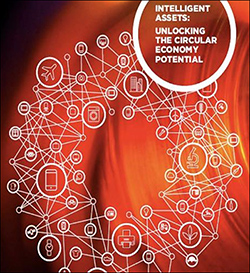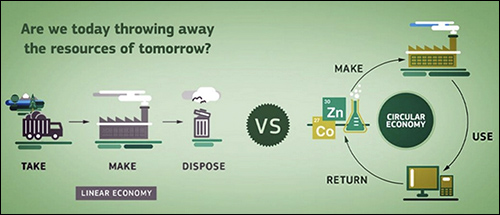Update: Lauren Roman will present a webinar, hosted by AIM, on Wednesday, June 29, at 11 EST. More information here.
Europe recently committed more than $6 billion to build a circular economy, and U.S. and global corporations are taking note. So, what is a circular economy? Let’s start with the basics.
Our usual “take – make – (maybe recycle) – dispose” linear economic model just does not work. This model places the onus for material recovery on consumers, cities and towns. It also contributes to the degradation of materials, and fails to recapture or reuse the energy required to manufacture products.

Alternately, a circular economic model is one that is restorative and regenerative by design and aims to keep products, components and materials at their highest utility and value at all times. An apparel manufacturer, for example, can integrate RFID into clothing so customers can get information on the product’s origin, such as ensuring that an item was created ethically, for example, and enabling recyclers to identify fabrics for proper recovery. Manufacturers can sell “products as a service,” by providing ongoing access to goods rather than selling them directly to consumers, and maintaining the goods during their usef¬¬ul life before recovering and recycling them.
For the first time ever, we have the technology to identify, authenticate, locate and track materials so they can be maintained and recovered. IoT technologies will play a vital role in enabling circular economies.
In February of this year, the Ellen McArthur Foundation released a report titled “Intelligent Assets: Unlocking the Circular Economy Potential.” In it, Kate Brandt, who leads Google‘s sustainability program, is quoted thusly: “The Internet of Things…can play a key role in providing valuable data about energy use, under-utilised assets and material flows to help make businesses more efficient. [Its] role in building a more circular economy is critical….”

The report’s appendix includes 17 circular economy case studies, all supported by the IoT, including:
• Hewlett-Packard‘s Instant Ink service provides printing-as-a-service to individuals and small businesses. The IoT-connected printers send customers replacement cartridges, along with postage-paid envelopes for used cartridges, before they run out of ink. HP also collects data on the machine’s condition for predictive maintenance and planning for new product design
• Provenance, a UK-based technology firm, uses blockchain transactional database technology as a platform to help businesses and consumers keep track of materials and associated data, through use cycles. For example, a bicycle can be registered on the blockchain by the manufacturer using the frame number as a reference. The bike buyer can receive a digital passport that authenticates the manufacturer, provides important product information and logs any repairs that are made. Secondary buyers would then have an immutable history of the bike and its maintenance, making extended use of the asset much more probable.
This movement to circular economic systems is unlike any sustainability movement before, and is happening at a time like no other.
Circular economic models that benefit customers, the environment and society can also deliver the most financial reward. This year, the World Economic Forum concluded that by 2025, $1 trillion per year can be generated for the global economy and 100,000 new jobs can be created annually within the next five years, provided that companies focus on encouraging circular supply chains to increase reuse, remanufacturing and recycling. The IoT is the key.
So, where are the IoT businesses?

Many, if not all, top IoT target markets, such as retail, electronics and supply chain, have organizations and work groups that are dedicated to developing sustainable, circular business models that benefit society and the environment in addition to the bottom line. Few, if any, IoT companies are engaging these organizations.
• Last month, the U.S. Chamber of Commerce Foundation held a two-day conference on Mainstreaming the Circular Economy. The event included hour-long concurrent work sessions to discuss how circular economy models could be applied to the electronics, manufacturing, food and beverage, retail and consumer packaged goods sectors. Yet, with no IoT stakeholders on the panels, the IoT did not enter into the discussions.
• The Sustainable Apparel Coalition‘s members are a veritable who’s-who of apparel brands, retailers and manufacturers, yet almost no IoT technology providers currently participate in the organization.
• Sustainable Brands‘ member companies include global leaders in retail, consumer packaged goods, apparel, consumables, airlines, health care, automotive, electronics and supply chain. The upcoming Sustainable Brands 2016 conference, to be held next week in San Diego, will feature hundreds of speakers in more than 80 sessions covering four days—and not a single IoT provider will be presenting.
Circular economy initiatives are a new frontier for IoT businesses, but the IoT solutions supporting them are already here. Engaging vertical organizations focused on circular economy solutions offers a new way of promoting IoT solutions and your business.
Carpe circular economy!
Lauren Roman is the founder and principal of TransparentPlanet, a Seattle-area consultancy providing automatic identification and data collection (AIDC) companies with new strategies for promoting and growing their businesses. She also helps enterprises understand that the IoT can be a powerful tool for responsible business to earn their customers’ trust, as well as improve product transparency and lifecycle management.

